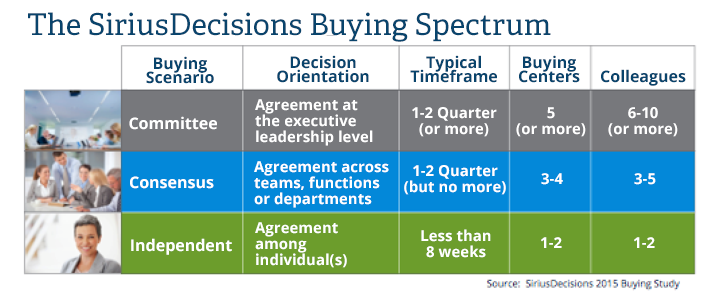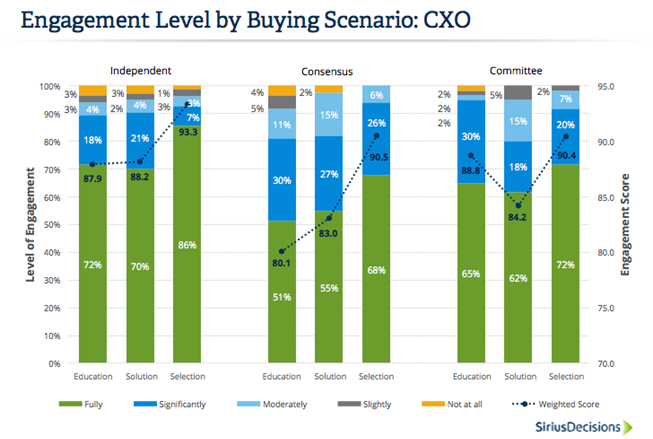There Is More Than One B2B Buyer’s Journey
- Our recent B2B buying study shows that there is not one buyer’s journey
- There are three common, distinct scenarios of buying behavior that we isolated
- Determine which buying scenario an offering is associated with to align go-to-market strategies to how B2B buyers buy
To help our clients understand their buyers, SiriusDecisions conducts significant and objective primary research. One of the most interesting discoveries revealed via our most recent B2B buying study is that there is not one buyer’s journey. In fact, there are three common, distinct scenarios of buying behavior that we isolated. It’s important to know which buying scenario that an offering or campaign is associated with in order to align go-to-market strategies to how B2B buyers buy.

Buying Scenario: Committee
This is a highly complex purchasing process; the buying decision is phased, structured and hierarchical. This scenario is typically associated with large buying entities, most commonly organizations with $1B or more in annual revenue, and representative of offering types with price ranges in the hundreds of thousands to more than $1 million. The length of the buying cycle clusters around six months; however, we observed many instances of the purchasing decision lasting longer – as much as a year or more to make a decision to buy (licensed members can read the brief “The SiriusDecisions Buying Decision Process Framework”). In a committee scenario, our study showed that six to 10 individuals were involved in the decision to purchase across multiple departments or functions (buying centers). The committee buying scenario requires the highest level of interaction between the buying entity and the provider organization to facilitate a decision to purchase an offering (licensed members can read the brief “The SiriusDecisions Buying Interaction Model”). We observed, on average, approximately 18 interactions (nine non-human intereactions and nine human-to-human interactions) occurring in this type of scenario.

Buying Scenario: Consensus
Consensus was the most common buying scenario that SiriusDecisions observed across all organizational size dimensions. Consensus is a team-based buying scenario where multiple people are involved across the organization. The typical price range for an offering in this scenario was $50-500MM USD (with longer tails for billion-plus for organizations with more than $500MM in revenue, and longer tails for under $50MM for emerging organizations [under $50MM in revenue]). In this buying scenario, the decision is horizontal and canvasses multiple departments or functions. It is not as complex as the committee buying decision because does not go to a senior level executive team, but it is still moderately complex as consensual decisionmaking is much harder to facilitate, given there are so many dynamics given the involvement of multiple buyer personas that must be influenced and informed in order to attain the vote to purchase the offering. We observed, on average, approximately 14 (seven non-human interactions and seven human-to-human interactions) occurring in this type of scenario.
Buying Scenario: Independent
This is a simple buying scenario where one or just a couple of people were involved in the decision to purchase, and the decision was easier to facilitate than committee or consensus decisions. The decision to purchase is made by one or two buyer personas and does not go either horizontal (consensus) or vertical (committee); the decision remains in a specific function or department. Thus, because the purchase is independent of the consensual voting or formal committee approval-type dynamics and there is no need to gain consensus represented by the other buying scenarios, the decision can be made independently or in isolation. It’s important to not confuse this scenario with transactional or e-commerce purchases. While the independent scenario is most related to those types of purchasing methods, our research has identified offerings purchased over the Internet in the other buying scenarios as well. This buying scenario is the least complex, as there is less impact from internal influencers and the provider only has to inform and persuade one or two key buyer personas. This makes it much easier to devise messaging, content and campaigns. The independent buying scenario requires the least amount of interaction between the buying entity and the provider organization to facilitate a decision to purchase an offering. We observed, on average, approximately 12 interactions (six non-human interactions and six human-to-human interactions) occurring in this type of scenario.
The 2015 SiriusDecisions B2B Buying Study reports observations from studying the recent B2B buying decisions of over 1,300 B2B executives across North America and Europe. Watch my Webcast to learn more and fuel your strategies for demand creation and lead nurturing.